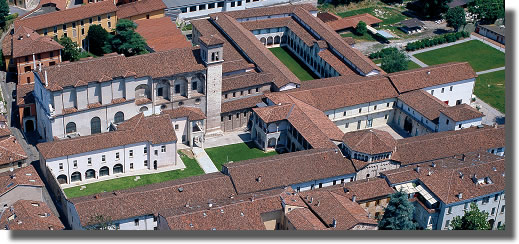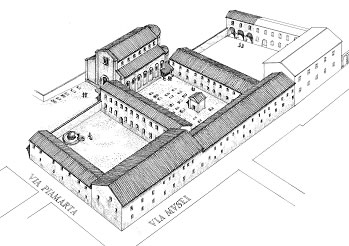BRESCIA
San Salvatore - Santa Giulia Complex
The Monastic complex of San Salvatore-Santa Giulia in Brescia is an extraordinary architectural palimpsest that incorporates the female Convent built in 753 by Duke Desiderio of Brescia, with his wife Ansa before he was crowned King.

The Church of San Salvatore is one of the most important evidences of late mediaeval architecture: the building, with triple apse transept, had three naves with a series of columns and capitals, some recycled from the classical era and from Byzantium, others made for this purpose. The Church, like the crypt, was entirely decorated with stuccoes and frescoes; the decorations, along with those of the Cividale Tempietto, are one of the richest and best preserved collections of the Early Middle Ages.
Within the Church, enhanced by a marble liturgical assemblage, can be found a number of tombs of the privileged , one of which is thought to be that of Desiderio's wife, Ansa.

Monastery of San Salvatore - Santa Giulia. Planimetry and axonometry of Longobard complex
The Monastery had service structures for the pilgrims reception and the poor housing; the complex area spread Westward with houses, burial places and productive plants. The walls evidences still visible in situ were discovered in what is considered to be the most complete medieval urban excavation, within an area where the most important pre-existing Roman remains in Northern Italy area preserved.
The Monastery played a fundamental role in the society of the time, both in religious and in political and economic terms.
To the West of the Monastic complex lies an Monumental archaeological area (that includes the Republican Sanctuary, the Capitolium and the Roman Theatre) closely linked to the events affecting San Salvatore-Santa Giulia at the time between Late Antiquity period and Early Middle Ages.
The archaeological area includes the area to the north of the Forum, namely, the heart of the ancient roman city, where all main functions were concentrated, be they religious, commercial, political or relating to the law. The most ancient religious building dates back to the second quarter of the 1st century A.D., thus to Republican times.
The excellent level of conservation, the architectural and decorative elements make this an unique example unparalleled in the area North of Rome.




